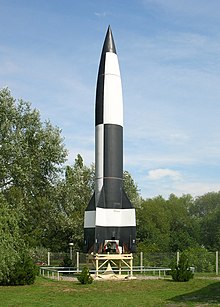
Back Wunderwaffe Afrikaans فوندرفافه Arabic Wunderwaffe Bulgarian Wunderwaffe Breton Wunderwaffe Catalan Wunderwaffe Czech Wunderwaffe Danish Wunderwaffen im Zweiten Weltkrieg German Wunderwaffe Spanish Wunderwaffe French
This article needs additional citations for verification. (November 2022) |





Wunderwaffe (German pronunciation: [ˈvʊndɐˌvafə]) is a German word meaning "wonder-weapon" and was a term assigned during World War II by Nazi Germany's propaganda ministry to some revolutionary "superweapons". Most of these weapons however remained prototypes, which either never reached the combat theater, or if they did, were too late or in too insignificant numbers to have a military effect.[1] The V-weapons, which were developed earlier and saw considerable deployment, especially against London and Antwerp, trace back to the same pool of highly inventive armament concepts. In the German language, the term Wunderwaffe generally refers to a universal solution which solves all problems related to a particular issue, mostly used ironically for its illusionary nature.
As the war situation worsened for Germany from 1942, claims about the development of revolutionary new weapons which could turn the tide became an increasingly prominent part of the propaganda directed at Germans by their government.[2] In reality, the advanced weapons under development generally required lengthy periods of design work and testing, and there was no realistic prospect of the German military being able to field them before the end of the war. When some advanced designs, such as the Panther tank and Type XXI submarine, were rushed into production, their performance proved disappointing to the German military and leadership due to inadequate pre-production testing or poorly planned construction processes.[3] Historian Michael J. Neufeld has noted that "the net result of all these weapons, deployed or otherwise, was that the Reich wasted a lot of money and technical expertise (and killed a lot of forced and slave laborers) in developing and producing exotic devices that yielded little or no tactical and strategic advantage".[4] However, a few weapons proved to be successful and have had a large influence in post-war designs.
- ^ Willy Ley, "V-2: Rocket Cargo Ship" Astounding Science Fiction, May 1945, repr. Famous Science-Fiction Stories: Adventures in Time and Space, (ed. J. Francis McComas, Raymond J. Healy, [1946], 1957), p. 359.
- ^ Tooze 2007, p. 611.
- ^ Tooze 2007, pp. 612–618.
- ^ Neufeld, Michael (13 April 2020). "The Myth of the German "Wonder-Weapons"". Smithsonian National Air and Space Museum. Retrieved 19 April 2020.
© MMXXIII Rich X Search. We shall prevail. All rights reserved. Rich X Search